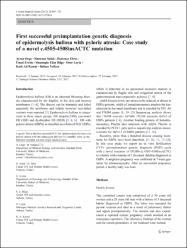| dc.contributor.author | Ayvaz, Özge | |
| dc.contributor.author | Hatırnaz, Şafak | |
| dc.contributor.author | Hatırnaz, Ebru | |
| dc.contributor.author | Ünsal, Evrim | |
| dc.contributor.author | Sinanoğlu, Ekin Bilge | |
| dc.contributor.author | Özer, Leyla | |
| dc.contributor.author | Baltacı, Volkan | |
| dc.date.accessioned | 2014-12-31T10:54:45Z | |
| dc.date.available | 2014-12-31T10:54:45Z | |
| dc.date.issued | 2012 | |
| dc.identifier.citation | Ozge A, Safak H, Ebru H, Evrim U, Bilge SE, Leyla O, Kemal KA, Volkan B. First successful preimplantation genetic diagnosis of epidermolysis bullosa with pyloric atresia: case study of a novel c.4505-4508insACTC mutation. Journal of Assisted Reproduction and Genetics. 2012; 29(4): 347-52. doi: 10.1007/s10815-012-9728-8. | en_US |
| dc.identifier.issn | 1058-0468 | |
| dc.identifier.uri | http://link.springer.com/article/10.1007%2Fs10815-012-9728-8 | en_US |
| dc.identifier.uri | http://www.ncbi.nlm.nih.gov/pmc/articles/PMC3309986/pdf/10815_2012_Article_9728.pdf | en_US |
| dc.identifier.uri | https://hdl.handle.net/11446/642 | en_US |
| dc.description | İstanbul Bilim Üniversitesi, Tıp Fakültesi. | en_US |
| dc.description.abstract | First successful preimplantation genetic diagnosis of epidermolysis bullosa with pyloric atresia: Case study of a novel c.4505-4508insACTC mutation
Introduction Epidermolysis bullosa (EB) is an inherited blistering disorder characterized by the fragility of the skin and mucous membranes [1–4]. The disease can be traumatic and lethal especially for newborns and infants however non-lethal variants were reported [5]. Epidermolysis bullosa is categorized in three major groups: EB simplex(EBS), junctional EB (JEB) and dysthrophic EB (DEB) [3, 4, 6] . EB with pyloric atresia (EBPA) is classified as a form of JEB. EBPA; which is inherited in an autosomal recessive manner is characterized by fragile skin and congenital atresia of the gastrointestinal tract (especially pylorus) [7–9]. α6β4 integrin levels are shown to be reduced or absent in EBPA patients. α6β4 of hemidesmosomes attaches the keratinocyte to the basal membrane and is encoded by ITG A6 and ITGB4 genes [8, 10–13] Sequencing analysis shows that ITGB4 accounts for%80, ITGA6 accounts for%5 of EBPA patients [14]. Another binding protein of hemidesmosomes, Plectin also interacts with α6β4. Plectin is encoded by PLEC1 gene and as sequencing analysis shows; accounts for the%15 of EBPA patients [15, 16]. Recently, more than a hundred disease causing mutations for EBPA have been described. [1, 10, 11, 17–23]. In this case study we report an in vitro fertilization (IVF)- preimplantation genetic diagnosis (PGD) cycle with a novel mutation of ITGB4 (c.4505-4508insACTC) to a family with a history of 3 deceased children diagnosed as EBPA. A singleton pregnancy was confirmed at 7-week gestation by ultrasonography. After an uneventful pregnancy period, a healthy baby was born. | en_US |
| dc.language.iso | eng | en_US |
| dc.publisher | Springer Verlag | en_US |
| dc.rights | info:eu-repo/semantics/openAccess | en_US |
| dc.title | First successful preimplantation genetic diagnosis of epidermolysis bullosa with pyloric atresia: Case study of a novel c.4505-4508insACTC mutation | en_US |
| dc.type | article | en_US |
| dc.relation.journal | Journal of Assisted Reproduction and Genetics | en_US |
| dc.department | DBÜ, Tıp Fakültesi | en_US |
| dc.identifier.issue | 4 | |
| dc.identifier.volume | 29 | |
| dc.identifier.startpage | 347 | |
| dc.identifier.endpage | 352 | |
| dc.contributor.authorID | TR157131 | en_US |
| dc.contributor.authorID | TR59881 | en_US |
| dc.contributor.authorID | TR57435 | en_US |
| dc.relation.publicationcategory | Belirsiz | en_US |


















